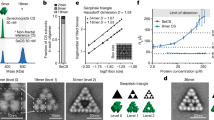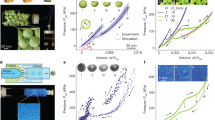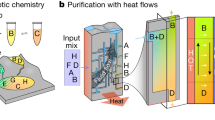Abstract
Although several strategies are now available to produce functional microcompartments analogous to primitive cell-like structures, little progress has been made in generating protocell constructs with self-controlled membrane permeability. Here we describe the preparation of water-dispersible colloidosomes based on silica nanoparticles and delineated by a continuous semipermeable inorganic membrane capable of self-activated, electrostatically gated permeability. We use crosslinking and covalent grafting of a pH-responsive copolymer to generate an ultrathin elastic membrane that exhibits selective release and uptake of small molecules. This behaviour, which depends on the charge of the copolymer coronal layer, serves to trigger enzymatic dephosphorylation reactions specifically within the protocell aqueous interior. This system represents a step towards the design and construction of alternative types of artificial chemical cells and protocell models based on spontaneous processes of inorganic self-organization.
This is a preview of subscription content, access via your institution
Access options
Subscribe to this journal
Receive 12 print issues and online access
$259.00 per year
only $21.58 per issue
Buy this article
- Purchase on Springer Link
- Instant access to full article PDF
Prices may be subject to local taxes which are calculated during checkout





Similar content being viewed by others
References
Stano, P., Carrara, P., Kuruma, Y., Souza, T & Luisi, P. L. Compartmentalized reactions as a case of soft-matter biotechnology: synthesis of proteins and nucleic acids inside lipid vesicles. J. Mater. Chem. 21, 18887–18902 (2011).
Pohorille, A. & Deamer, D. Artificial cells: prospects for biotechnology. Trends Biotech. 20, 123–128 (2002).
Städler, B. et al. Polymer hydrogel capsules: en route toward synthetic cellular systems. Nanoscale 1, 68–73 (2009).
Szostak, J. W., Bartel, D. P. & Luisi, P. L. Synthesizing life. Nature 409, 387–390 (2001).
Mann, S. Systems of creation: the emergence of life from non-living matter. Acc. Chem. Res. 45, 2131–2141 (2012).
Stano, P. & Luisi, P. L. Achievements and open questions in the self-reproduction of vesicles and synthetic minimal cells. Chem. Commun. 46, 3639–3653 (2010).
Dzieciol, A. & Mann, S. Designs for life: protocell models in the laboratory. Chem. Soc. Rev. 41, 79–85 (2012).
Walde, P. Building artificial cells and protocell models: experimental approaches with lipid vesicles. Bioessays 32, 296–303 (2010).
Koga, S., Williams, D. S., Perriman, A. W. & Mann, S. Peptide/nucleotide micro-droplets as a step towards a membrane-free protocell model. Nature Chem. 3, 720–724 (2011).
Williams, D. S. et al. Polymer/nucleotide droplets as bio-inspired functional micro-compartments. Soft Matter 8, 6004–6014 (2012).
Li, M., Green, D. C., Anderson, J. L. R., Binks, B. P. & Mann, S. In vitro gene expression and enzyme catalysis in bio-inorganic protocells. Chem. Sci. 2, 1739–1745 (2011).
Cooper, G. J. T. et al. Modular redox-active inorganic chemical cells: iCHELLs. Angew. Chem. Int. Ed. 50, 10373–10376 (2011).
Subramaniam, A. B., Wan, J., Gopinath, A. & Stone, H. A. Semi-permeable vesicles composed of natural clay. Soft Matter 7, 2600–2612 (2011).
Dinsmore, A. D. et al. Colloidosomes: selectively permeable capsules composed of colloidal particles. Science 298, 1006–1008 (2002).
Wu, C., Bai, S., Ansorge-Schumacher, M. B. & Wang, D. Nanoparticle cages for enzyme catalysis in organic media. Adv. Mater. 23, 5694–5699 (2011).
Boker, A., He, J., Emrick, T. & Russell, T. P. Self-assembly of nanoparticles at interfaces. Soft Matter 3, 1231–1248 (2007).
Wang, D. Y., Duan, H. W. & Mohwald, H. The water/oil interface: the emerging horizon for self-assembly of nanoparticles. Soft Matter 1, 412–416 (2005).
Shah, R. K., Kim, J-W. & Weitz, D. A. Monodisperse stimuli-responsive colloidosomes by self-assembly of microgels in droplets. Langmuir 26, 1561–1565 (2010).
Hsu, M. F. et al. Self-assembled shells composed of colloidal particles: fabrication and characterization. Langmuir 21, 2963–2970 (2005).
Thompson, K. L. & Armes, S. P. From well-defined macromonomers to sterically-stabilized latexes to covalently cross-linkable colloidosomes: exerting control over multiple length scales. Chem. Commun. 46, 5274–5276 (2010).
Subramaniam, A. B., Abkarian, M. & Stone, H. A. Controlled assembly of jammed colloidal shells on fluid droplets. Nature Mater. 4, 553–556 (2005).
Kim, J-W. et al. Colloidal assembly route for responsive colloidosomes with tunable permeability. Nano Lett. 7, 2876–2880 (2007).
Lee, D. & Weitz, D. A. Double emulsion-templated nanoparticle colloidosomes with selective permeability. Adv. Mater. 20, 3498–3503 (2008).
Weaver, J. V. M. & Adams, D. J. Synthesis and application of pH-responsive branched copolymer nanoparticles (PRBNs): a comparison with pH-responsive shell cross-linked micelles. Soft Matter 6, 2575–2582 (2010).
Harbron, R. L., McDonald, T. O., Rannard, S. P., Findlay, P. H. & Weaver J. V. M. One-pot, single-component synthesis of functional emulsion-templated hybrid inorganic–organic polymer capsules. Chem. Commun. 48, 1592–1594 (2012).
Martin, W. & Russell, M. J. On the origins of cells: a hypothesis for the evolutionary transitions from abiotic geochemistry to chemoautotrophic prokaryotes, and from prokaryotyes to nucleated cells. Phil. Trans. R. Soc. Lond. B 358, 59–85 (2003).
Acknowledgements
We thank Parogle Technologies Ltd for a Collaborative Award in Science and Engineering (CASE) funded studentship for R.L.H, and A. Peacock (Centre for Materials Discovery, University of Liverpool) for running GPC samples. We thank the Engineering and Physical Sciences Research Council and the European Research Council (Advanced Grant scheme) for financial support. This paper is dedicated to the memory of J.V.M.W.
Author information
Authors and Affiliations
Contributions
M.L. and S.M. conceived the concept, S.M. directed the research, M.L., R.L.H. and J.V.M.W. designed and performed the experiments and analysed the data, and B.P.B. contributed the surface-active nanoparticles and discussions on colloid science. All the authors participated in writing the paper.
Corresponding authors
Ethics declarations
Competing interests
The authors declare no competing financial interests.
Supplementary information
Supplementary information
Supplementary information (PDF 6069 kb)
Rights and permissions
About this article
Cite this article
Li, M., Harbron, R., Weaver, J. et al. Electrostatically gated membrane permeability in inorganic protocells. Nature Chem 5, 529–536 (2013). https://doi.org/10.1038/nchem.1644
Received:
Accepted:
Published:
Issue Date:
DOI: https://doi.org/10.1038/nchem.1644
This article is cited by
-
Superstructural ordering in self-sorting coacervate-based protocell networks
Nature Chemistry (2024)
-
Signal processing and generation of bioactive nitric oxide in a model prototissue
Nature Communications (2022)
-
Living material assembly of bacteriogenic protocells
Nature (2022)
-
Gas marbles: ultra-long-lasting and ultra-robust bubbles formed by particle stabilization
Frontiers of Chemical Science and Engineering (2022)
-
Chemical communication at the synthetic cell/living cell interface
Communications Chemistry (2021)



